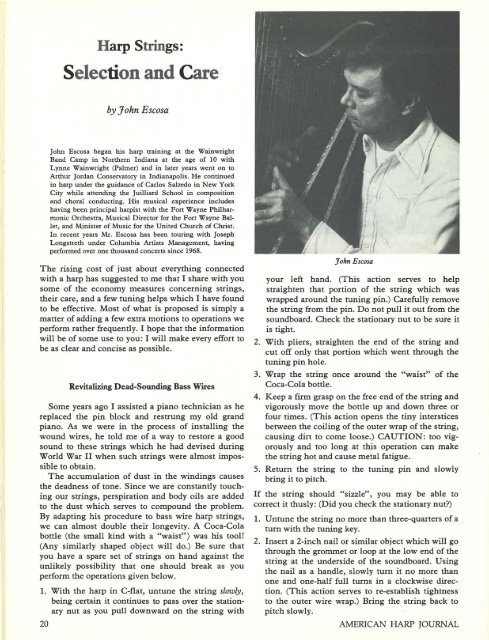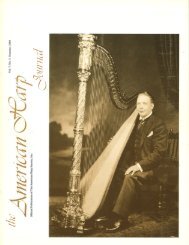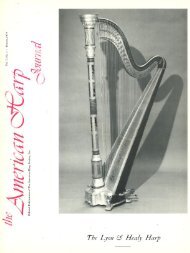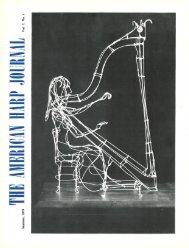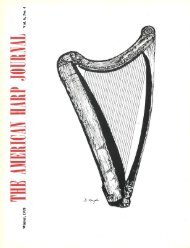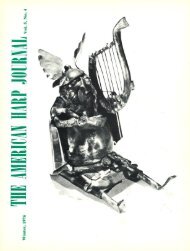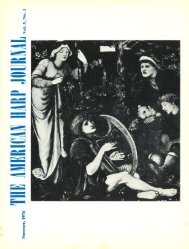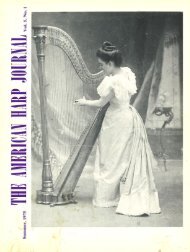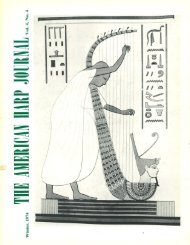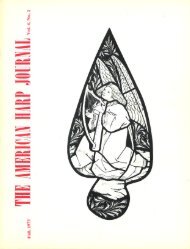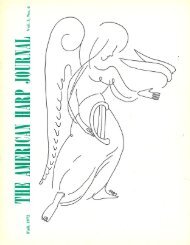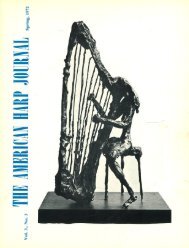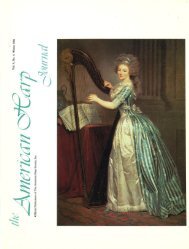You also want an ePaper? Increase the reach of your titles
YUMPU automatically turns print PDFs into web optimized ePapers that Google loves.
Harp Strings:<br />
Selection and Care<br />
by John Escosa<br />
John Escosa began his harp training at the Wainwright<br />
Band Camp in <strong>No</strong>rthern Indiana at the age of 10 with<br />
Lynne Wainwright (Palmer) and in later years went on to<br />
Arthur Jordan Conservatory in Indianapolis. He continued<br />
in harp under the guidance of Carlos Salzedo in New York<br />
City while attending the Juilliard School in composition<br />
and choral conducting. His musical experience includes<br />
having been principal harpist with the Fort Wayne Philharmonic<br />
Orchestra, Musical Director for the Fort Wayne Ballet,<br />
and Minister of Music for the United Church of Christ.<br />
In recent years Mr. Escosa has been touring with Joseph<br />
Longstreth under Columbia Artists Management, having<br />
performed over one thousand concerts since· 1968.<br />
The rising cost of just about everything connected<br />
with a harp has suggested to me that I share with you<br />
some of the economy measures concerning strings,<br />
their care, and a few tuning helps which I have found<br />
to be effective. Most of what is proposed is simply a<br />
matter of adding a few extra motions to operations we<br />
perform rather frequently. I hope that the information<br />
will be of some use to you: I will make every effort to<br />
be as clear and concise as possible.<br />
Revitalizing Dead-Sounding Bass Wires<br />
Some years ago I assisted a piano technician as he<br />
replaced the pin block and restrung my old grand<br />
piano. As we were in the process of installing the<br />
wound wires, he told me of a way to restore a good<br />
sound to these strings which he had devised during<br />
World War II when such strings were almost impossible<br />
to obtain.<br />
The accumulation of dust in the windings causes<br />
the deadness of tone. Since we are constantly touching<br />
our strings, perspiration and body oils are added<br />
to the dust which serves to compound the problem.<br />
By adapting his procedure to bass wire harp strings,<br />
we can almost double their longevity. A Coca-Cola<br />
bottle (the small kind with a "waist") was his tool!<br />
(Any similarly shaped object will do.) Be sure that<br />
you have a spare set of strings on hand against the<br />
unlikely possibility that one should break as you<br />
perform the operations given below.<br />
1. With the harp in C-flat, untune the string slowly,<br />
being certain it continues to pass over the stationary<br />
nut as you pull downward on the string with<br />
20<br />
John Escosa<br />
your left hand. (This action serves to help<br />
straighten that portion of the string which was<br />
wrapped around the tuning pin.) Carefully remove<br />
the string from the pin. Do not pull it out from the<br />
soundboard. Check the stationary nut to be sure it<br />
is tight.<br />
2. With pliers, straighten the end of the string and<br />
cut off only that portion which went through the<br />
tuning pin hole.<br />
3. Wrap the string once around the "waist" of the<br />
Coca-Cola bottle.<br />
4. Keep a firm grasp on the free end of the string and<br />
vigorously move the bottle up and down three or<br />
four times. (This action opens the tiny interstices<br />
between the coiling of the outer wrap of the string,<br />
causing dirt to come loose.) CAUTION: too vigorously<br />
and too long at this operation can make<br />
the string hot and cause metal fatigue.<br />
5. Return the string to the tuning pin and slowly<br />
bring it to pitch.<br />
If the string should "sizzle", you may be able to<br />
correct it thusly: (Did you check the stationary nut?)<br />
1. Untune the string no more than three-quarters of a<br />
turn with the tuning key.<br />
2. Insert a 2-inch nail or similar object which will go<br />
through the grommet or loop at the low end of the<br />
string at the underside of the soundboard. Using<br />
the nail as a handle, slowly turn it no more than<br />
one and one-half full turns in a clockwise direction.<br />
(This action serves to re-establish tightness<br />
to the outer wire wrap.) Bring the string back to<br />
pitch slowly.<br />
AMERICAN HARP JOURNAL


